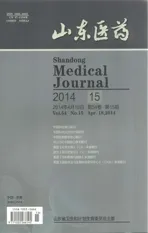上皮—间质转化及其在鼻咽癌中的作用研究进展
2014-04-05赵利容罗泊涛陈小毅
饶 洁,赵利容,罗泊涛,陈小毅
(广东医学院病理学教研室,广东湛江524023)
鼻咽癌(NPC)是一种与Epstein-Barr病毒(EBV)感染密切相关的鼻咽部黏膜上皮恶性肿瘤,对放疗较敏感,但大多数患者在初次确诊时已有局部淋巴结或远处转移,处于临床Ⅲ或Ⅳ期[1],晚期患者放疗后仍有30%~40%发生远距离转移和局部复发[2],侵袭和转移仍是威胁患者生存的关键因素之一。上皮—间质转化(EMT)是肿瘤发生侵袭转移的重要机制,且与NPC原位侵袭和远处转移密切相关。现将EMT在NPC中的作用研究进展综述如下。
1 EMT定义及特征
EMT的概念由Greenburg和Hay在1982年首次提出,指上皮细胞在某些特定条件下转化为具有间质样表型细胞的生物学过程。EMT现象最初用于解释胚胎的发育过程,如神经管、心瓣膜、颅面部结构和肌肉、骨骼等的形成。随后陆续发现,EMT存在于多种病理过程中,如伤口的愈合、组织纤维化、假上皮瘤样增生和肿瘤侵袭转移等。因此,EMT所起的具体作用可分为以下三型:Ⅰ型为胚胎发育和器官形成;Ⅱ型为纤维化—损伤修复、组织再生;Ⅲ型为肿瘤发生及转移。上皮细胞发生EMT后,其形态由椭圆形转变为长梭形(呈成纤维细胞样形态),且细胞极性丧失、细胞间连接解体、细胞骨架重排、细胞运动和侵袭能力增加;此外,上皮表型蛋白E-cadherin表达降低或消失,间质表型蛋白Vimentin、Fibronectin和N-cadherin表达上调[3]。
2 介导NPC细胞发生EMT的相关因子
2.1 EBV编码蛋白 在NPC等上皮细胞型肿瘤中,EBV感染主要表达Ⅱ型潜伏感染产物,如EBV核抗原1 (EBNA-1)、潜伏膜蛋白1(LMP-1)、潜伏膜蛋白2 (LMP-2)和EBV编码的小RNAs(EBERs)[4]。众多研究表明,在NPC中EBV感染产物与EMT有关。
EBNA-1是一种由EBV编码、641个氨基酸组成的核蛋白,其包含的两个连接区是维持病毒基因组连接于细胞染色体并持续存在的基本结构。EBNA-1蛋白的羧基端含有一个与DNA结合的亲水结构域,可以与特异的双链DNA序列结合形成二聚体并促进病毒编码的相应蛋白转录。在细胞内因子辅助下,EBNA-1羧基端DNA结合区与EBV复制起始点结合,激活LMP-1的启动子,促进LMP-l转录;还可激活Hedgehog(HH)信号通路[5],而HH信号通路可介导EMT。EBNA-1转染EBV相关胃癌细胞后,可下调与EMT相关的miR-200家族表达,随后上调 ZEB1/ZEB2表达,导致 E-cadherin表达减少[6]。王路等也发现,过表达EBNA-1的NPC细胞系发生了与EMT相关的细胞形态和表型变化,过表达EBNA-1可通过TGF-β1使miR-200a和miR-200b表达下调,进而上调其靶基因ZEB1、ZEB2转录因子诱导NPC细胞发生EMT并促进其侵袭和转移。
LMP-1是由EBV基因组BNLF-1基因编码、386个氨基酸组成的相对分子质量为62×103Da的跨膜蛋白。LMP-1与NPC细胞的EMT关系密切[7~10]。体外实验表明,LMP-1可通过诱导EMT相关转录因子Twist[7]、Snail[8]促进NPC细胞发生EMT和增强其侵袭转移能力。NPC组织中LMP-1与Twist、Vimentin表达呈正相关[9];稳定表达LMP-1的鼻咽上皮细胞呈现肿瘤干细胞(CSC)样表型、具有自我更新的特性,同时伴有EMT转录因子Twist和Snail表达水平升高[10]。LMP-1可促使NPC细胞系CNE-1的SATB-1表达增加和核转位,体内实验表明LMP-1与SATB-1呈正相关,且SATB-1蛋白表达水平与NPC临床分期、淋巴结转移、远距离转移也呈正相关[11]。SATB-1在乳腺癌细胞获得和维持侵袭转移能力的过程中起关键性作用,且其高表达可下调E-cadherin表达,敲除此基因后E-cadherin表达显著增强、E-cadherin的转录抑制因子Snail表达明显下调、癌细胞的EMT过程被逆转[12]。但有学者[9]认为,LMP-1也许仅仅是NPC发生EMT有关的上游因子之一,而非NPC颈部淋巴结转移的决定因子。
EBV编码的LMP-2包含LMP-2A和LMP-2B,其中LMP-2B的主要功能是负性调节LMP-2A[13]。LMP-2A是由497个氨基酸组成的相对分子质量为54×103Da的磷酸化膜蛋白,其可通过Ras/PI3-K/ Akt、ERK 1/2等信号通路介导EMT[14~16],如其氨基末端脯氨酸富集基序可激活ERK 1/2信号通路,诱导基质金属蛋白酶(MMP)-9启动子活化所需的AP-1转录因子Fra-1,从而上调MMP-9表达、促进NPC细胞侵袭[16]。LMP-2A转染EBV相关胃癌细胞后,可下调与EMT相关的miR-200家族表达、上调ZEB1/ZEB2表达,导致E-cadherin表达降低[6]。此外,LMP-2A在诱导NPC细胞发生EMT时,也可增加NPC组织中CSC样细胞群体数量[15]。
2.2 细胞因子及其他因素 缺氧诱导因子(HIF)、胰岛素样生长因子(IGF)、表皮生长因子(EGF)、肝细胞生长因子(HGF)、成纤维细胞生长因子(FGF)、血管内皮生长因子(VEGF)及转化生长因子(TGF)等均可诱导多种恶性上皮肿瘤细胞发生EMT,从而促进肿瘤侵袭和转移[17]。TGF-β1[18]、EGF、HGF与NPC细胞发生EMT有关,其中EGF可激活PI3-K/Akt信号[19],而HGF则可激活ERK 1/2信号[20]。此外,通过自分泌或旁分泌的IL-8活化AKT信号亦可诱导NPC细胞发生EMT[21]。Zhen等[22]发现,NPC组织中结缔组织生长因子(CTGF)的表达下调,且与NPC临床进展呈负相关;稳定下调或暂时抑制NPC的6-10B细胞系中CTGF表达可激活FAK/PI3-K/Akt信号通路,进而促进与细胞侵袭和转移相关的MMP-2、MMP-9及EMT相关基因Snail、N-cadherin、波形蛋白表达,并使E-cadherin表达降低;但并未发现NPC的6-10B细胞出现EMT形态学变化,其机制有待进一步研究。负调节ERK活性的双特异性磷酸酶(DUSP6)在NPC组织中表达亦下调,通过质粒转染后过表达DUSP6的高侵袭性NPC细胞的侵袭能力明显减弱,而EMT相关标志物E-cadherin表达上调、Vimentin表达下调,提示DUSP6可减弱NPC细胞浸润和EMT相关表型表达[23]。
2.3 miRNAs miRNAs是一类内源性、非编码的小分子RNAs,主要参与细胞发育、增殖、分化和转移等生物过程[24]。miRNAs通过与mRNA的3'UTR区完全或部分互补结合导致靶mRNA降解或转录后翻译抑制,从而调控靶基因表达。LMP-1可通过EMT转录因子Twist上调miR-10b表达,而miR-10b过表达可促进NPC转移,但不清楚Twist能否直接诱导miR-10b转录[25];miR-29c在NPC细胞中表达下调可导致编码与细胞迁移和转移有关的细胞外金属蛋白多个靶 mRNA水平上调,如 COL4A1、COL4A2、COL3A1等7个胶原蛋白基因及Lamininγ1、Fibrillin、FUSIP-1等,从而促进肿瘤侵袭和转移[26]。miR-200a可通过靶向作用于ZEB2 mRNAs等抑制NPC细胞生长、迁移和侵袭[27],并分别通过靶向ZEB2和β-catenin信号调控EMT和干细胞样细胞生成[28]。此外,miR-149可通过下调E-cadherin调控NPC细胞的EMT[29]。
3 EMT与NPC组织中CSC
CSC是指肿瘤组织中一小部分具备某些与干细胞相似特征的细胞,具有无限增殖分化、自我更新、形成新肿瘤灶的能力,被认为是肿瘤转移、复发和放化疗抵抗的根源[30,31]。发生EMT的细胞可能具有干细胞样表型[32]。体外实验表明,LMP-2A诱导NPC细胞发生EMT时,亦可增加CSC样细胞的群体数量[15],而后者比非 CSC样细胞更容易发生EMT[33];LMP-1诱导NPC细胞产生CSC样表型过程中伴有EMT发生[10]。在NPC组织中,胚胎性干细胞标志物(SOX2、OCT4、Nanog和Nestin)与EMT相关指标(E-cadherin/N-cadherin和Snail)呈显著相关[34]。NPC细胞株CNE-2中的CSC样侧群细胞高水平表达干细胞相关基因OCT4、SOX2、Nanog及间质细胞相关基因N-cadherin、Vimentin和Snail,低水平表达上皮细胞相关基因E-cadherin[33]。
4 EMT在NPC临床治疗中的作用
临床上NPC以放疗为主,但放疗抵抗仍是制约疗效的瓶颈,而肿瘤放疗抵抗可能与EMT有关[35]。在梯度射线照射体外NPC细胞过程中,随射线总量增加NPC细胞形态由多边形变成长梭形,同时其上皮标志物表达逐渐下降、间质标志物表达明显升高,表明EMT改变可能是NPC细胞放疗抵抗的重要原因之一[36]。此外,放疗过程中NPC细胞的Akt可被异常激活[37],后者则可促进NPC细胞发生EMT并增强放疗抵抗;Akt的特异性抑制剂gsk690693可通过抑制Akt激活,阻断放射所致ZEB1和Vimentin表达、恢复E-cadherin表达,从而防止肿瘤细胞的迁移和EMT、增加体内外肿瘤细胞对电离辐射的灵敏度[38]。有些膳食治疗有助于逆转NPC细胞的EMT,如绿茶中的没食子儿茶素可抑制已经获得EMT特性的高侵袭能力NPC细胞的成瘤和侵袭能力、下调EMT相关蛋白的表达,在靶向EMT治疗和减少NPC复发和转移中起一定作用;白藜芦醇可通过激活多种细胞凋亡通路诱导NPC细胞凋亡[39],亦可通过活化p53抑制癌干细胞属性如EMT、高侵袭性等。
综上所述,EMT在NPC侵袭转移、维持CSC样特性和放疗抵抗中具有重要作用,可能是晚期患者放疗后仍有远距离转移和局部复发的原因;以EMT为靶点的治疗途径将成为探索逆转放疗抵抗、预防肿瘤转移和复发的新策略,并可为肿瘤个体化治疗提供新的依据。
[1]Zhang L,Zhu YX,Wang Y,et al.Salvage surgery for neck residue or recurrence of nasopharyngeal carcinoma:a 10-year experience[J].Ann Surg Oncol,2011,18(1):233-238.
[2]Ma BB,Chan AT.Recent perspectives in the role of chemotherapy in the management of advanced nasopharyngeal carcinoma[J].Cancer,2005,103(1):22-31.
[3]Christiansen JJ,Rajasekaran AK.Reassessing epithelial tomesenchymal transition as a prerequisite for carcinoma invasion and metastasis[J].Cancer Res,2006,66(17):8319-8326.
[4]Young LS,Rickinson AB.Epstein-Barr virus:40 years on[J].Nat Rev Cancer,2004,4(10):757-768.
[5]Port RJ,Pinheiro-Maia S,Hu C,et al.Epstein-Barr virus induction of the Hedgehog signaling pathway imposes a stem cell phenotype on human epithelial cells[J].JPathol,2013,231(3):367-377.
[6]Shinozaki A,Sakatani T,Ushiku T,et al.Downregulation ofmicroRNA-200 in EBV-associated gastric carcinoma[J].Cancer Res,2010,70(11):4719-4727.
[7]Horikawa T,Yang J,Kondo S,et al.Twist and epithelial-mesenchymal transition are induced by the EBV oncoprotein latentmembrane protein 1 and are associated with metastatic nasopharyngeal carcinoma[J].Cancer Res,2007,67(5):1970-1978.
[8]Horikawa T,Yoshizaki T,Kondo S,et al.Epstein-Barr virus latentmembrane protein 1 induces Snail and epithelial-mesenchymal transition in metastatic nasopharyngeal carcinoma[J].Br JCancer,2011,104(7):1160-1167.
[9]Yue L,Jiang Z,Wu W,et al.Latentmembrane protein-1 of EB virus and the phenotype of epithelial-mesenchymal transition and cervical lymph node metastasis in nasopharyngeal carcinoma[J].Lin Chung Er Bi Yan Hou Tou JingWai Ke Za Zhi,2011,25(6): 270-273.
[10]Kondo S,Wakisaka N,Muramatsu M,etal.Epstein-Barr virus latentmembrane protein 1 induces cancer stem/progenitor-like cells in nasopharyngeal epithelial cell lines[J].J Virol,2011,85 (21):11255-11264.
[11]Shen Z,Zeng Y,Guo J,et al.Over-expression of the special AT rich sequence binding protein 1(SATB1)promotes the progression of nasopharyngeal carcinoma:association with EBV LMP-1 expression[J].JTransl Med,2013,11(1):217.
[12]Han HJ,Russo J,Kohwi Y,et al.SATB1 reprogrammes gene expression to promote breast tumour growth and metastasis[J].Nature,2008,452(7184):187-193.
[13]RovedoM,Longnecker R.Epstein-Barr virus latentmembrane protein 2B(LMP2B)modulates LMP2A activity[J].JVirol,2007,81(1):84-94.
[14]Fukuda M,Longnecker R.Epstein-Barr virus latent membrane protein 2Amediates transformation through constitutive activation of the Ras/PI3-K/Akt Pathway[J].J Virol,2007,81(17):9299-9306.
[15]Kong QL,Hu LJ,Can JY,et al.Epstein-Barr virus-encoded LMP2A induces an epithelial-mesenchymal transition and increases the number of side population stem-like cancer cells in nasopharyngeal carcinoma[J].PLoSPathog,2010,6(6):e1000940.
[16]Lan YY,Hsiao JR,Chang KC,et al.Epstein-Barr virus latent membrane protein 2A promotes invasion of nasopharyngeal carcinoma cells through ERK/Fra-1-mediated induction ofmatrixmetalloproteinase 9[J].JVirol,2012,86(12):6656-6667.
[17]Said NA,Williams ED.Growth factors in induction of epithelialmesenchymal transition and metastasis[J].Cells Tissues Organs,2011,193(1-2):85-97.
[18]陆伟,李萍,冯大益,等.鼻咽癌原发与转移性淋巴结E-cadherin和TGF-β1表达相关性的探讨[J].中华肿瘤防治杂志,2011,18(4):269-271.
[19]Yip WK,Seow HF.Activation of phosphatidylinositol 3-kinase/ Akt signaling by EGF downregulates membranous E-cadherin and β-catenin and enhances invasion in nasopharyngeal carcinoma cells[J].Cancer Lett,2012,318(2):162-172.
[20]黎志勋,梁英杰,廖志群,等.肝细胞生长因子体外活化ERK1/ 2途径诱导鼻咽癌细胞上皮—间叶性转换[J].广东医学,2007,28(9):1406-1408.
[21]Li XJ,Peng LX,Shao JY,et al.As an independent unfavorable prognostic factor,IL-8 promotesmetastasisof nasopharyngeal carcinoma through induction of epithelial-mesenchymal transition and activation of AKT signaling[J].Carcinogenesis,2012,33(7): 1302-1309.
[22]Zhen Y,Ye Y,Yu X,et al.Reduced CTGF expression promotes cell growth,migration,and invasion in nasopharyngeal carcinoma[J].PLoSOne,2013,8(6):e64976.
[23]Wong VC,Chen H,Ko JM,etal.Tumor suppressor dual-specificity phosphatase 6(DUSP6)impairs cell invasion and epithelialmesenchymal transition(EMT)-associated phenotype[J].Int J Cancer,2012,130(1):83-95.
[24]Bartel DP.MicroRNAs:target recognition and regulatory functions[J].Cell,2009,136(2):215-233.
[25]Li G,Wu Z,Peng Y,et al.MicroRNA-10b induced by Epstein-Barr virus-encoded latentmenbrane protein-1 promotes themetastasis of human nasopharyngeal carcinoma cell[J].Cancer Lett,2010,299(1):29-36.
[26]Sengupta S,den Boon JA,Chen IH,et al.MicroRNA 29c is down-regulated in nasopharyngeal carcinomas,up-regulating mRNAs encoding extracellularmatrix proteins[J].Proc Natl Acad Sci USA,2008,105(15):5874-5878.
[27]Xia H,Ng SS,Jiang S,etal.miR-200a-mediated downregulation of ZEB2 and CTNNB1 differentially inhibits nasopharyngeal carcinoma cell growth,migration and invasion[J].Biochem Biophys Res Commun,2010,391(1):535-541.
[28]Xia H,Cheung WK,Sze J,et al.miR-200a regulates epithelialmesenchymal to stem-like transition via ZEB2 andβ-catenin signaling[J].JBiol Chem,2010,285(47):36995-37004.
[29]Luo Z,Zhang L,Li Z,et al.miR-149 promotes epithelial-mesenchymal transition and invasion in nasopharyngeal carcinoma cells[J].Zhong Nan Da Xue Xue Bao Yi Xue Ban,2011,36(7):604-609.
[30]Kondo T,Setoguchi T,Taga T.Persistence of a small subpopulation of cancer stem-like cells in the C6 glioma cell line[J].Proc Narl Acad Sci U SA,2004,101(3):781-786.
[31]Gupta PB,Chaffer CL,Weinberg RA.Cancer stem cells:mirage or reality[J].Nat Med,2009,15(9):1010-1012.
[32]Mani SA,Guo W,Liao MJ,et al.The epithelial-mesenchymal transition generates cells with properties of stem cells[J].Cell,2008,133(4):704-715.
[33]Guo D,Xu BL,Zhang XH,et al.Cancer stem-like side population cells in the human nasopharyngeal carcinoma cell line CNE-2 possess epithelialmesenchymal transition properties in association with metastasis[J].Oncol Rep,2012,28(1):241-247.
[34]LuoW,Li S,Peng B,etal.Embryonic stem cellsmarkers SOX2,OCT4 and Nanog expression and their correlations with epithelialmesenchymal transition in nasopharyngeal carcinoma[J].PLoS One,2013,8(2):e56324.
[35]Chiba N,Comaills V,Shiotani B,et al.Homeobox B9 induces epithelial-to-mesenchymal transition-associated radioresistance by accelerating DNA damage responses[J].Proc Natl Acad SciUSA,2012,109(8):2760-2765.
[36]Li G,Liu Y,Su ZW,et al.Irradiation induced epithelial-mesenchymal transition in nasopharyngeal carcinoma in vitro[J].Chin J Otorhinolaryngol Head Neck Surg,2013,48(8):662-667.
[37]Liu Y,Chen LH,Yuan YW,etal.Activation of AKT is associated with metastasis of nasopharyngeal carcinoma[J].Tumour Biol,2012,33(1):241-245.
[38]Chen W,Wu S,Zhang G,et al.Effectof AKT inhibition on epithelial-mesenchymal transition and ZEB1-potentiated radiotherapy in nasopharyngeal carcinoma[J].Oncol Lett,2013,6(5):1234-1240.
[39]Huang TT,Lin HC,Chen CC,etal.Resveratrol induces apoptosis of human nasopharyngeal carcinoma cells via activation ofmultiple apoptotic pathways[J].JCell Physiol,2011,226(3):720-728.
